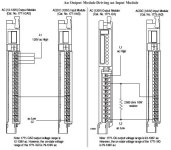Hello guys and gals.
I have an older plc that has triac outputs. I recently installed new devices with solidstate inputs. The outputs from the plc turn on the inputs on new devices.
I think I might be having a problem with leakage current from the triac. I know if I put in an isolating relay the problems go away. So I assume leakage is the problem.
But, I have 48 outputs that need relays to work. Our SCADA system (plcs included) are in the design phase of getting upgraded so the relays would only be temporary.
Is there any cheaper way that I can get these devices to work without bying 48 relays and bases?
All replies appreciated.
I have an older plc that has triac outputs. I recently installed new devices with solidstate inputs. The outputs from the plc turn on the inputs on new devices.
I think I might be having a problem with leakage current from the triac. I know if I put in an isolating relay the problems go away. So I assume leakage is the problem.
But, I have 48 outputs that need relays to work. Our SCADA system (plcs included) are in the design phase of getting upgraded so the relays would only be temporary.
Is there any cheaper way that I can get these devices to work without bying 48 relays and bases?
All replies appreciated.





